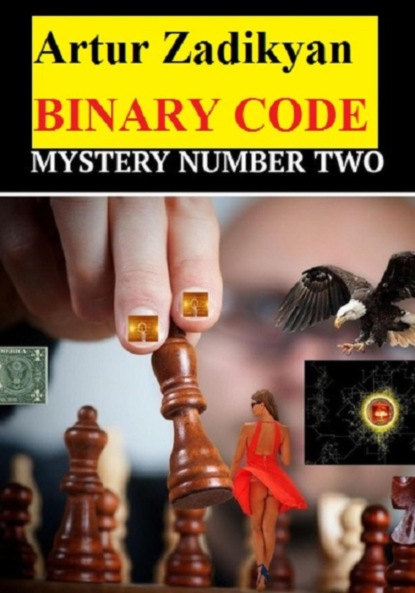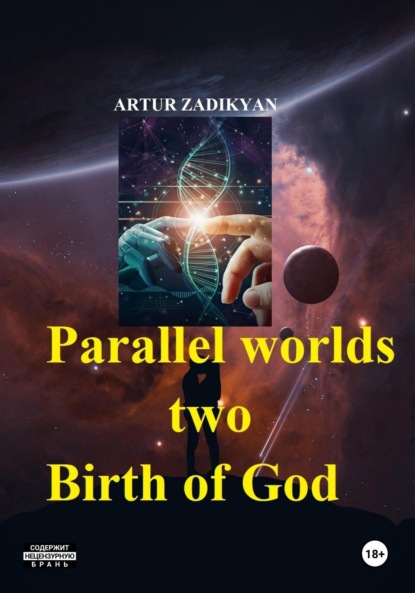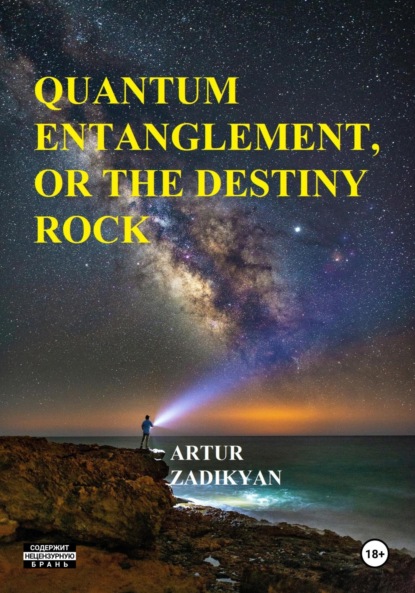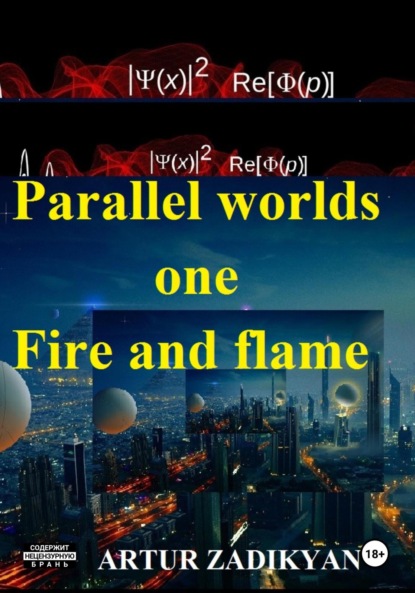
Полная версия:
Artur Zadikyan Parallel Worlds pro et contra
- + Увеличить шрифт
- - Уменьшить шрифт

Artur Zadikyan
Parallel Worlds pro et contra
Book One. Chapter 1. In the beginning there was a thought

A moment changes eternity. Eternity is made up of moments
– In the beginning, there was a thought. Remember, Rutra, in the beginning there was a thought. Now you don't pay much attention to it, but the time will come and it will be very important, because those who know what was in the beginning always hide it, otherwise it cannot be. Because those who know the original event, and certainly those who have done the first action in the beginning, can put the order of action together so that, by controlling all the subsequent actions, they can bring the event to the result that was originally intended. So remember these words. You can make so many things out of a word! And imagine how much can be done with a thought. Because a word can influence people both positively and negatively, both constructively and destructively. But words are always manifest. We hear and perceive them, so we can examine, understand, assume, draw conclusions from their content. Thought, on the other hand, is always hidden. But there are things that are even more hidden and unknown even to our thoughts. This is what gives birth to thought.
He said this "hidden truth" with a kind of mysterious mysticism, almost in a whisper. Then, glancing at Ruthra, studying his reaction, which he knew Ruthra was not hiding, he continued:
– Therefore, know this: there are truths that not everyone can know, not everyone can be privy to. To control actions, one must control thoughts. To control thoughts, you have to be able to give that which gives birth to thought. If you want to be initiated into this.....
He fell silent halfway through the sentence without completing it.
Ruthra drew meaningful conclusions from what was said and from what was left unspoken. Warpath, as his name was, radiated his thoughts, so Ruthra could feel them before they were transformed into words.
– You will be part of this truth, because only the chosen ones can be in this system. This truth is as old as the world, everyone feels it, but only those who see its action with their own eyes will believe in its reality. Once you are convinced of it, you will understand more than others, you will know what they do not realize. All faith is based on such knowledge (when you are convinced of the reality of what is unnatural to others), and the crown of it is faith in the most supernatural, that is, in God. It is therefore a very powerful force. But at the same moment keep in mind: you can enter this river, but you cannot get out. Now I am going to tell you something that will be difficult for you to accept, and I don't even know from which point of view it will be better to accept it – religious or scientific.
– Tell it like it is.
He couldn't see the man's face through the darkness, and he couldn't understand how he'd gotten here. Ruthra was suddenly swirling in a whirlwind of doubt and anxiety as he thought about what had happened. He couldn't remember what had happened before, couldn't figure out where he was or who was talking to him. When he looked more closely, he was astonished, almost horrified. He saw through his interlocutor. Another thought intertwined with the questionable perception of reality and the search for reasons: "How do I know his name is Warpath? I'm sure of it." Suddenly his companion reached out to him with an outstretched forefinger. His voice became restless.
– Now you'll realize what this is about, but it's false....
– What?" asked Ruthra with difficulty, as suddenly the surroundings became lighter and lighter, more and more, he was blinded… the interlocutor was disappearing.
Ruthra was the last to see Warpath's glittering eyes and finally recognized them. It made him realize what was happening, but at the same time it made him doubt his perception of reality. The bright light obscured the vision, and only Varpath's last words, coming from the depths of vast time and space, magically inspired not only faith in the reality of that vastness, but also confidence in the thought they had provoked. A thought that is that samsara, the unity and opposite of birth and death, that connects desire and idea to stimulate action. An action that can generate new thoughts that can spin the wheel of samsara, combining desire and idea to generate new actions whose meaning will be to get out of that wheel. Exit to a new circle, which is possible if the action generated by the thought, connected by desire and idea, has a point of attainment. The point of achievement is the goal.
– She's waiting in parallel worlds.
The last words of the disappearing Warpath echoed in Ruthra's ears. He was gone, and Ruthra opened his eyes. He was lying in a mind-moving machine.
***
We want our lives to be full of new, bright, unusual things. We live in expectation of it, often hoping for a miracle. However, sometimes expectations are prolonged for a long time, and we realize that everything expected will not come by itself, and then we wish for another life. Everyone outlines this other direction of life's path in his or her own way, thinking and imagining something out of crumpled desires and fantasies.
But not everyone has the strength to even imagine something bigger than their current life. Many people cannot formulate what they really want, and someone considers their small desires as a huge unattainable dream and even the whole meaning of life. A very small percentage of people decide to try to realize at least something of their fantasies. Even fewer are those who can be called the "elite of will": such individuals are able, at any stage of their lives, to change this very life and realize their dreams.
Something similar happened to Rutra. Everything seemed to be fine, his job, his status, his level in the hierarchy of power, but the stars had decided otherwise. Rutra believed in the influence of the stars (or anything from chance to God) only insofar as he could explain it scientifically, so he was morally close to the theory he had been drawn into.
It was the theory of many worlds. Few people knew that the theory about the existence of many worlds, which are copies, consequence or consequence of our world, is studied scientifically and there are quite logical hypotheses. One of them is faced by a human being with each of his actions: the state of the world now and in infinity depends on how we act. So people change the world they live in, and only because they know only the one they feel, they consider it to be the only real one. If at the moment of choosing some action several of us would appear and each of us would act differently, and then after a huge period of time all of us would meet and tell what the world has become depending on that action – then we would be able to comprehend parallel worlds in reality. Now we can only rejoice (or regret, depending on the result) what happened, or suppose what would have happened if we had managed to do something differently then, in the past.
Unexpectedly, even for himself, Ruthra found himself at a crossroads. He wanted to realize his life's dream, which was to fly to distant worlds. Not just to space, but to the very distant worlds that no one not only knew about, but did not even believe in. After all, for us to believe in the existence of life (all the more intellectual) in the cosmos is akin to the feeling of a humanoid, wild creature who realized his superiority over the animal world. It was the realization of one's status as an intelligent human being that was the sense of grandeur that gave rise to god. A god. Only an intellectually evolved being could want an intellectual parent – something greater by all accounts. Only that could have been the impetus for the development of anything whose basis was intelligence. And no matter how diverse and comprehensive the intellect changed – everything was not enough for it. That is why he was always transforming his gods, making them what he wanted to strive for. And with time he became disappointed in himself, and the gods he invented became irrelevant, "inanimate", unreal. Then the society was thrown into chaos, and in time common sense and new ideals were forged in this flame of cruelty and mercy, which led the intellect, helping to overcome the wild animal instincts and passions. Very often we receive signals that can move us to action, but not everyone sees them, hears them, feels them, and many do not want to, ignore them, more often because of the fear of responsibility before the unknown. Except that most people believe in God, which, in fact, is a symbol of the unknown, mystery, although it is personified by faith in the hope of his love for us and hope in the faith of help and salvation of us by our love for him. The unity and struggle of opposites very often lead us into confusion and are the fault of indecision. But the brave take fortresses. And if word and idea are added to it, the fortress will fall without sacrifice. Society will accept a new god: otherwise it not only has no one to defend itself against, but it sees this new god as its defense now.
Chapter 2. The Fix

Creative people, and not only talented people (each of us is talented in something, even in stupidity), always have a fix idea. And if this idea finds support in the statements of great thinkers, it turns from an idea into a goal.
Rutra has always wondered why the formula E=MC2 limits the possibilities of mankind. According to this contradictory and controversial (including the authorship) formula – bodies with mass cannot reach the speed of light, otherwise the energy must be infinite, and massless particles (there are some) can, but no more. So, at the speed of light you fly to the Moon (+/-300,000 km) one second, to the Sun (150,000,000 km) already more than 8 minutes. The Sun is our star, and there are up to 400,000,000,000,000,000,000 of them in our galaxy alone (not the largest). The diameter of our galaxy is 100,000 light years. Imagine how many seconds that is. Even if we reach the speed of light for human flight (which is incredible and contradicts all the laws of physics), it will take us 4 years to fly to the nearest star – Alpha Centauri (and back 4). To say that we, even overcoming all the laws of physics, can fly around at least our galaxy (to our neighbor, the Andromeda Nebula, 2,000,000 light years away) is still impossible!
So, Rutra had a fix idea. He has developed a program and is preparing to implement it, which will be a scientific breakthrough. First he needs to realize no less ambitious and grandiose idea, very original, fateful for mankind, incredible, but in fact, as it turned out, has a very simple solution. It is only necessary to give immortality to mankind. This incredible and seemingly unfeasible idea turned out to be solvable in one rather simple way. As it turns out, it is a very simple solution, even on a physiological level. Everything grandiose is simple. It was much more difficult to overcome the speed of light.
The idea had so strongly occupied Rutra's mind that everything else became unimportant. Obsessed with the idea, he set out to carry out his plan.
Chapter 3. The intrigue of the beginning

– You're awake, and you're not dreaming.
– What?
– Listen. This is happening in your world.
Ruthra saw the council meeting. His friend and colleague was gesticulating and talking emotionally. He saw, as if from above, everyone at once. But that wasn't what struck Ruthra. What struck him was that he saw among them a person who should not have been there according to all the laws of physics. By all the laws he thought were unshakable. Rutra saw himself.
– …However, please understand my further methodology of proposing, presenting and even explaining the project. Not everyone is proficient in this area. Not everyone is well versed in the exact sciences. Now how can I say this so as not to offend… I will be listened to, the topic studied and approved by more than just the board members. Right? That's right. And, no offense, there's a lot of people in the system – financiers, military, specialists in other fields.
– Mr. Doctor, let's get on topic," the chairman asked rather loudly and firmly.
– Okay, here I go. Everything that can be imagined exists. Otherwise it can't be imagined. The idea of the world is in the brain, in representations. The many-worlds interpretation, or the Everett interpretation, is an interpretation of quantum mechanics that assumes the existence (in a sense) of "parallel universes", each with the same laws of nature and the same world constants in different states.
The Council did not need to be told about the scientific background of the theory of multiple worlds. For the average person such a thing was perceived as a fantasy, because not everyone knew that there was a scientific basis for the existence of parallel worlds. There were several explanations, among them – the Copenhagen interpretation, Everett's many-worlds interpretation and other similar ones. The point is that the scientific community studied this issue, so no one could take the speaker's words lightly. Everyone tried to understand how it was possible, knowing his past, no less fantastic ideas, which still managed to materialize.
This time he stated that indeed there are these parallel worlds, moreover – they are an exact copy of ours. As proof, the scientist cited quantum teleportation. Since not everyone to whom he presented his program understood the subtleties of his reasoning, the speaker made detailed explanations.
– Now a little scientific justification of cloning methods, digitalization of memory and existence of other civilizations that exactly repeat our world. For example, everyone knows about animal cloning and the technique of rapid breeding of, for example, broiler chickens. This is how, by slightly transforming the technology, we make human clones. A person is "created" within a year. The next stage is loading consciousness into him. It seems incredible, but it's much simpler than that. This is achieved by recording the brain radiation and then converting this radiation into a form that affects the chemical reactions in the brain. In this way, one brain state is transmitted to another. After all, you are not surprised when your thoughts, converted by you into words (and scientifically into waves of sound), travel to the ear, from there to the brain, and there cause the desired reactions. You can read about the existence of brain waves, their transmission to the apparatuses in the network. For example, you can use your thoughts to type what you read. Not with words, but with thoughts. All this is already real. Now the question is: Are there other worlds? This can be answered in terms of both religion and science. It's a win-win to convince you. Surely you either believe in god or science, and most people believe in both in different interpretations. So, let's take an example from the Bible, and in almost all known religions there is a mention of other worlds: "And the other inhabitants of the universe have not fallen". And the scientific example is based on probability and imagination about infinity. Here you are, can you imagine infinity, for example, of time and space? Whatever magnitude you imagine – there must be something beyond it. From this follows a logical conclusion: there is everything in infinity. And if you have doubts now, it means that you have imagined the smallest part of this infinity.
Chapter 4. Where am I? Who am I?

"Where the hell am I? I was in the center. Is this the real world or virtual reality?"
– Irene, you on the line?
There was no response.
– Irene, are you there? Where am I?
"Yeah, well, maybe the doctor was right. And yet… how to check whether it was his trick, a joke, a virtual reality, or really, damn it, it worked out. It's an understatement… Am I in a parallel world? Is it parallel? Once people could not believe in the existence of other lands, much less continents. And the existence of different races, nations, round Earth, which in addition moves around the axis and, quite surprisingly, around the Sun, it turns out, was no less fantastic. And the end of the atmosphere and further endless airless space could not be imagined at all. So it only seems at first that the existence of other worlds is something fantastic. It's not. It turns out to be simple. Or maybe it's a virtual reality? Maybe this is Earth, and what's going on is Parmen's prank. After his prank one can expect anything, and after the incomprehensions with virtual worlds in my last job, I have serious doubts… A person living in Africa, for example, in the Bronze Age, who had never seen snow, would be transported to the Arctic to the Eskimos. They would wake him up and explain that the world is round, there is a moon and planets that revolve around the sun, these are earthlings like you, and so on. What would he think? He would have thought he was crazy, or still asleep, or a prank, or dead, or in another world. Lots of things he would think, and the hardest thing for him to figure out would be how it was that the Earth was round. So now… it seems logical that there should be other worlds in the infinity of the universe, it seems logical that life should originate in the same conditions as it already did, that is, develop in a similar way, but it is very hard to believe it, especially to believe that you are there now. Just like an ancient inhabitant of the Earth. For whom the world is the outskirts that he sees from a distant hill or even a mountain…"
Rutra's musings were interrupted by a policeman.
– Paschow, out.
"Well, I've had a bit of an accident. I wonder what role I'm playing here…" – Ruthra thought, having already convinced himself that there really were parallel worlds and that he was out of the cage. The guardian of order walked forward. Ruthra followed him. "That's strange," he thought. – He should handcuff me first… or there should be two of them, one in the back and one in the front. But really, I wouldn't know. Especially in this world. Or this is our world… There's no difference yet."
– Rutra Tigrovich, go directly to the Admiral's office. Today he's in the office without a sign, the secret one.
Ruthra was about to ask where, to whom, and why, when he realized that something was wrong. The policeman had been very friendly to him, and it seemed that the place where he was to go was not a hostile place.
Soon he saw the mark of a removed sign on one of the doors. He knocked. The owner of the office himself opened the door. In the spacious room at the entrance stood a tall, blue-eyed, blond-haired, statuesque man.
– Hey, buddy. Enough lying around in sanatoriums, it's time to get down to business," he began.
Ruthra tried to contact Irene silently. She wasn't answering. He needed information. He didn't understand what was going on or how to behave, much less what to answer.
– It's time. What's the plan?
– The plan is the same, but we'll change it a little, and we'll need to add more men," the man spoke a little quickly and, as it seemed to Ruthra, even with some apprehension. – I'll send all the input and disposition data over the alternate communications system. Irene is under control and on lockdown for most functions for you. All the more reason for her to keep quiet and not give you any data.
– Can artificial intelligence be persuaded?
– Rutra, are you brain-dead from the daily marathon to the TV tower?
– Uh… I don't think so. Must have been a heavy sleeper.
Ruthra was about to ask what the TV tower was, but stopped just in time.
– You did it yourself, and they realized it. Although you and Irene are on very good terms, she'll tell you in confidence.
– Got it.
– Be careful with Yat-san. She's undecided about her role, she's always under the influence. She's also very peculiar and can change her mind at any time. And she has a problem that she thinks about more than the case. Jules has a problem. She plays three sides. And she's willing to play the fourth.
– Oh, shit. Who's that?
– The first party is you. You have a theme with her. The second story is between you and YatSan, she's doing diplomacy. And is constantly in touch and conspiring with Petty: periodically we record a deeply encrypted communication with Andrian.
– With Andrian?
– Why is that particularly surprising to you?
Ruthra needed to show awareness and keep the conversation going, even though he didn't know any Andrian or any of the people in question. For some reason, he felt this was the right thing to do. Perhaps it was a subconscious memory of the person whose body his consciousness had entered in this world.
– Andrian is not inclined to conspire.
– She must have asked for it very much. Maybe it's for your own good. At least that's how she presented it to him.
– How?
– I don't have time to analyze it. There's nothing special there. There are topics related to YatSan. Your personal and work relationships are a bit tangled.
– The program requires complete trust, and there is no way to do it without personal sympathy.
– Your sympathies have crossed some lines.
Ruthra thought, "What's the deepest thing he knows about… And what in the world could I possibly have done?"
– What about Catherine?
– Catherine is calm, stable. She doesn't mind having an affair. Quite the risk-taker at heart. Loves to get her adrenaline pumping. Hang gliding, skydiving. You wouldn't know it from her passion.
– She's in a secret relationship with who?
– You should know that yourself and report to me. We are preparing you there, after all," the admiral said the last in a whisper and pointed his finger upward. – She's in touch with everyone, but I can't call them secret. She's sort of facilitating their plans.
– So what are their plans?
– It's likely that Andrian will tell you everything at some stage. And Irene… and probably something in Catherine's secret. Iulia and Shallow are dangerous. You can expect anything from them. Most of all, Eulalia. She uses everyone.
– I wonder how.
– She's got a gut feeling, or there's something we don't know. Maybe there's a leak. It sounds to me like you're being friendly and overly trusting. A woman is still a woman. A fish seeks the deepest, a woman seeks the best.
– I obviously missed something.
– She knows… and most likely from you, even if in passing… indirectly you mentioned it.
– About our program?
– Yeah. About what we're cooking. About what we are preparing you there, – he said again in a whisper and pointed his finger upwards. – The people are ready, the Kantemirov division, by the way, too.
– I tried to keep that little guy away from me.
– But you first let Iulia get close to you, and then you let YatSan get even closer. They were all in doubt then, but now that the prospect is looming, they have become more active and are ready to make any kind of conspiracy.
– How does this threaten the program?
– Have you been drinking too much? I don't think you've been drinking. I don't need you to explain what power is. Especially power in Russia. We don't know who they're connected to or who's behind them. We've got our eye on Chalky. He's very dangerous. Sit down, why are you standing up like a soldier? Let's have a drink to celebrate the victory. Although we don't celebrate in advance… Then let's start.
Ruthra didn't quite know what was going on, and only the television on was telling him what was going on. Four sectors of the screen were showing simultaneously. Demonstrations were going on in Moscow. People were walking mostly peacefully. They carried banners, sang songs and shouted into megaphones. Sometimes singers, actors, creative personalities, politicians and scientists performed in the squares. The main theme boiled down to distrust of the past elections. The theme was unambiguously clear. Everything spoke about it: both the banners and the voice message. The main demand – give change. Many people were repeating a learned and invented cry: "My grandfather lived under stagnation, my father under stagnation, I under stagnation". And from the tribunes and squares they were saying: "Volodya, go away. Volodya, go away for God's sake. Volodya, you're our friend, but the truth is dearer. Volodya, go away with a calm soul, there are still smart people in Russia, imagine that".







